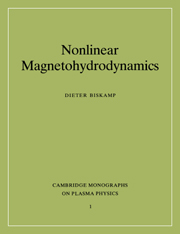Book contents
- Frontmatter
- Contents
- Preface
- 1 Introduction
- 2 Basic properties of magnetohydrodynamics
- 3 Magnetostatic equilibria
- 4 Normal modes and instability
- 5 Nonlinear evolution of MHD instabilities
- 6 Magnetic reconnection
- 7 MHD turbulence
- 8 Disruptive processes in tokamak plasmas
- 9 Dynamics of the reversed-field pinch
- 10 Solar flares
- Outlook
- References
- Index
5 - Nonlinear evolution of MHD instabilities
Published online by Cambridge University Press: 15 December 2009
- Frontmatter
- Contents
- Preface
- 1 Introduction
- 2 Basic properties of magnetohydrodynamics
- 3 Magnetostatic equilibria
- 4 Normal modes and instability
- 5 Nonlinear evolution of MHD instabilities
- 6 Magnetic reconnection
- 7 MHD turbulence
- 8 Disruptive processes in tokamak plasmas
- 9 Dynamics of the reversed-field pinch
- 10 Solar flares
- Outlook
- References
- Index
Summary
The study of linear stability of plasmas had for a long period been carried by the conception that only stable configurations can exist in nature, since instability would lead to destruction of the equilibrium and loss of plasma confinement, which would be the faster the larger the growth rate. Statements like: “all plasmas (meaning real inhomogeneous plasma configurations) are unstable”, sometimes pronounced by plasma theoreticians in the heyday of instability theory, seemed to imply that magnetic fusion research is basically a futile endeavor. The development in experimental plasma physics during the past two decades proved this conception thoroughly wrong. Tokamak discharges may exist, well confined, in spite of the presence of instabilities, which often lead only to a slight change of the plasma profiles and a certain increase of plasma and energy transport (and which may even have beneficial effects such as the removal of impurities by the sawtooth process). Thus in order to judge the effect of an instability it is evidently necessary to calculate or at least estimate its nonlinear behavior, in particular the saturation level. It will turn out that linear mode properties, in particular growth rates, often have little to say about the nonlinear behavior.
As a general rule an instability is found to be the more “dangerous”, i.e. its effect on the plasma configuration is the more detrimental, the longer the wavelength (global modes).
- Type
- Chapter
- Information
- Nonlinear Magnetohydrodynamics , pp. 85 - 126Publisher: Cambridge University PressPrint publication year: 1993



